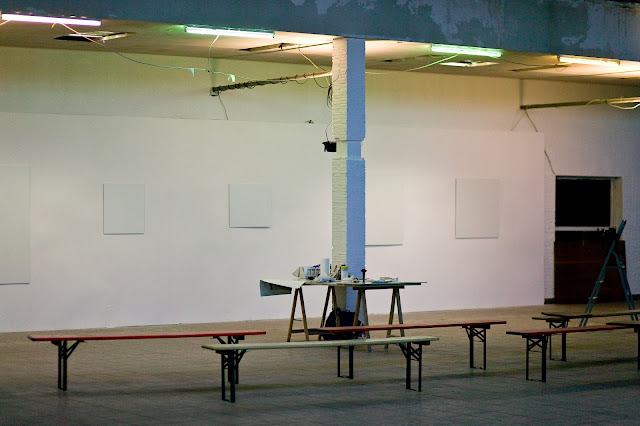The composition '1,1,1,2,3'
 |
| Yasamin Saffarian, Naime Pakniat, Hosna Falsafi and Azade Rahimi as a guest |
dear Mr.Koval
as i told you we tried to make a new framework by your formula,11123, here's i attached a photo of what we made,but we have a problem,we were compare the work you and your team created at the performance with the same formula and we realize that your work had so much more elements and your work surface was almost fully covered by the elements but we have many empty areas in our work and it seems so empty!...did you repeated the lines of 11123 formula for two or three times to get to that composition or what else?
it would be our pleasure if you give your worth time to answer to us
best regards, hosna
Dear Hosna,
your guess, that we repeated the lines is correct.
We haven't posted a final version of this composition yet since the part of the procedure was still lacking some information.
This is now the updated version of the composition '1,1,1,2,3' with a full description of the procedure:
'1,1,1,2,3', Oleksiy Koval, 2012
M 1/25
R [*1,1,1,2,3]
E |a,b,c,d,...| ≈
P
The rhythmical motive:
Element a starts with a solo using the rhythmical motive.
Then element a paints the same rhythmical motive, but in cooperation with the following two elements (b,c).
Element b has its solo and so on ...
[*a,a,a,aa,aaa]
[*a,a,a,ab,abc]
a makes four times a mark of the unit size 1
b chooses one of the four and makes a new unit of the size 2 by adding its mark in the unit size 1
a makes another mark of the unit size 1
b chooses again one of the four and makes a new unit of the size 2 by adding its mark in the unit size 1
c chooses one of the two units of the size 2 and makes one new unit of the size 3 by adding its mark in
the unit size 1
[*b,b,b,bb,bbb]
[*b,b,b,bc,bcd]
[*c,c,c,cc,ccc]
[*c,c,c,cd,cde]
[*d,d,d,dd,ddd]
[*d,d,d,de,def]
...
The surface:
Start in area 1 or 5 and then move to the next area, either left to right, right to left or top to bottom until the row is completed.
The element wich comes next decides where to continue:
If you move horizontally it can be the area on the left or right border of the following row
or if you move vertically it can be the area on the top or bottom border of the following row.
This decision can be made for each row.
M meter
R rhythmical motive
E element
P procedure
* hits the meter
|| order fixed
[] within the same area
≈ size of the unit is corresponding for all elements
The idea behind this composition is to have a simple, repetitive structure, which allows for example to vary in speed while painting.
------------------------
Dear Hosna,
your guess, that we repeated the lines is correct.
We haven't posted a final version of this composition yet since the part of the procedure was still lacking some information.
This is now the updated version of the composition '1,1,1,2,3' with a full description of the procedure:
'1,1,1,2,3', Oleksiy Koval, 2012
M 1/25
R [*1,1,1,2,3]
E |a,b,c,d,...| ≈
P
The rhythmical motive:
Element a starts with a solo using the rhythmical motive.
Then element a paints the same rhythmical motive, but in cooperation with the following two elements (b,c).
Element b has its solo and so on ...
[*a,a,a,aa,aaa]
[*a,a,a,ab,abc]
a makes four times a mark of the unit size 1
b chooses one of the four and makes a new unit of the size 2 by adding its mark in the unit size 1
a makes another mark of the unit size 1
b chooses again one of the four and makes a new unit of the size 2 by adding its mark in the unit size 1
c chooses one of the two units of the size 2 and makes one new unit of the size 3 by adding its mark in
the unit size 1
[*b,b,b,bb,bbb]
[*b,b,b,bc,bcd]
[*c,c,c,cc,ccc]
[*c,c,c,cd,cde]
[*d,d,d,dd,ddd]
[*d,d,d,de,def]
...
The surface:
Start in area 1 or 5 and then move to the next area, either left to right, right to left or top to bottom until the row is completed.
The element wich comes next decides where to continue:
If you move horizontally it can be the area on the left or right border of the following row
or if you move vertically it can be the area on the top or bottom border of the following row.
This decision can be made for each row.
M meter
R rhythmical motive
E element
P procedure
* hits the meter
|| order fixed
[] within the same area
≈ size of the unit is corresponding for all elements
The idea behind this composition is to have a simple, repetitive structure, which allows for example to vary in speed while painting.
http://www.youtube.com/watch?feature=player_embedded&v=5iJOiVd-E9A#t=2497
Some examples of the results:
Some examples of the results:
 |
"1,1,1,2,3" Mixed Media auf Papier, 60x70 cm, Munich, 2012 Pascal Geiger, Oleksiy Koval, Kuros Nekouian, Stefan Schessl, Veronika Wenger, Daniel Worsch |
We hope this could answer your question. Please, feel free to ask, if something is still not clear.
The Beautiful Formula Collective


Comments
Post a Comment